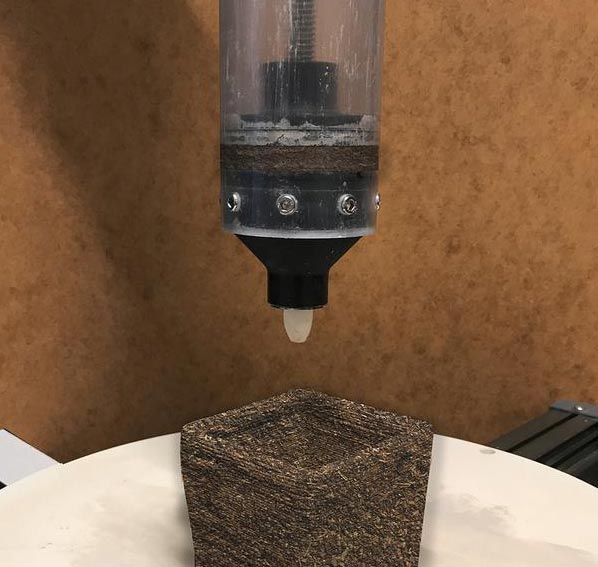Fungus as a sound absorber

3D printing of a sample based on mycelium.
© Fraunhofer UMSICHT
Sustainable soundproofing
As healthy and tasty as mushrooms might be, they are good for much more than just the dinner plate. The Fraunhofer Institute for Environmental, Safety and Energy Technology UMSICHT has now teamed up with the Fraunhofer Institute for Building Physics IBP to investigate the use of fungus-based materials for the fabrication of eco-friendly sound absorbers.
The incessant chatter of office coworkers who are always on the phone or the loud music of a noisy neighbor are a source of stress for many people. That’s because ambient sound does indeed affect our well-being and health. Sound absorbers can improve a room’s acoustics. Many of the soundproofing panels used in walls or room fittings in today’s interior designs are made of mineral fibers or synthetic foams. Some of these materials are not particularly sustainable or easily recycled. In a bid to bring to market an eco-friendlier and more effective alternative, Fraunhofer UMSICHT is working with Fraunhofer IBP to develop sound absorbers made of fungus-based materials.
The original idea came from Julia Krayer, project manager at Fraunhofer UMSICHT in Oberhausen. She has been working on biomaterials for many years. “There’s currently a focus on vegetal substrates and mycelium for the development of new materials.” Krayer explains. Mycelium consists of a fine network of filament-like hyphae. In its
natural habitat, mycelium grows underground, where it may span more than a square kilometer.
For the current project, Krayer and colleagues are growing hyphae in the lab. This mycelium is first mixed with a vegetal substrate consisting of straw, wood and waste from food production, and then printed into the desired shape by means of a 3D printer. “The mycelial hyphae spread throughout the substrate and create a solid structure,” says Krayer. Once the mycelium has permeated the fine-grained substrate, the product is dried in a kiln in order to kill the fungus. The cell walls of the resulting material are open, meaning that it will absorb sound. With its open cells and 3D-printed porous structure, it is ideal for soundproofing purposes.
Targeted pore structure that can be produced using a 3D printer
Sound absorbers made of fungus-based materials have a range of advantages – they are effective, sustainable and help conserve resources. Moreover, as Roman Wack, a project partner from Fraunhofer IBP in Stuttgart, explains: “The material, which is permeated by mycelium, has a solid structure. This means that much thinner layers of it could be used to make sound absorbers.” Similarly, the use of a 3D printer enables the creation of a predefined porous structure within the absorber. The printer is programmed to produce this structure, which can then be progressively enhanced as research advances. This will help developers perfect their design. In other words, they can reasonably expect this method to deliver a sound absorber that is made of renewables yet outperforms today’s conventional products.
Their priority right now is the fabrication of sustainable sound absorbers. At present, employees at Fraunhofer UMSICHT are producing a range of prototypes for a sustainable sound absorber, which will then be tested at Fraunhofer IBP.
Clothing and furniture from fungus-based material
The potential applications for this mycelial material are not limited to acoustics. “The end products could probably be used as insulating material, but this would require more intensive research,” says Krayer. The prospects of using mycelium as a base material for fungal faux leather, fabric and plastic also look promising. In the future, fungus-based materials could be used not only to produce sound absorbers and insulating materials, but also clothing, furniture and housings for electrical appliances. Research is already underway to make this possible.
Weitere Informationen:
https://www.fraunhofer.de/en/press/research-news/2021/january-2021/fungus-as-a-s…
Media Contact
All latest news from the category: Architecture and Construction
Newest articles

Innovative 3D printed scaffolds offer new hope for bone healing
Researchers at the Institute for Bioengineering of Catalonia have developed novel 3D printed PLA-CaP scaffolds that promote blood vessel formation, ensuring better healing and regeneration of bone tissue. Bone is…

The surprising role of gut infection in Alzheimer’s disease
ASU- and Banner Alzheimer’s Institute-led study implicates link between a common virus and the disease, which travels from the gut to the brain and may be a target for antiviral…

Molecular gardening: New enzymes discovered for protein modification pruning
How deubiquitinases USP53 and USP54 cleave long polyubiquitin chains and how the former is linked to liver disease in children. Deubiquitinases (DUBs) are enzymes used by cells to trim protein…



